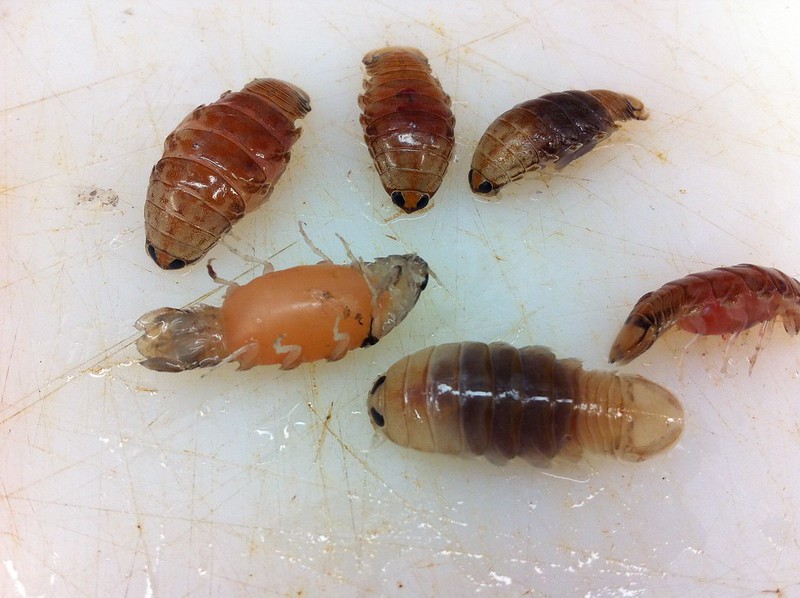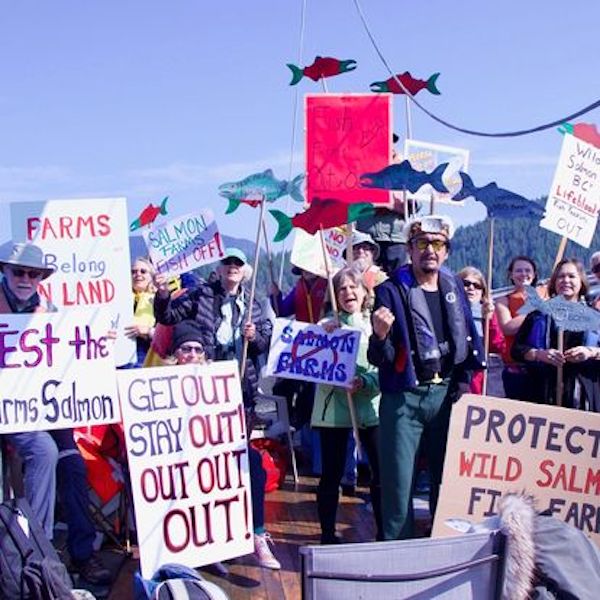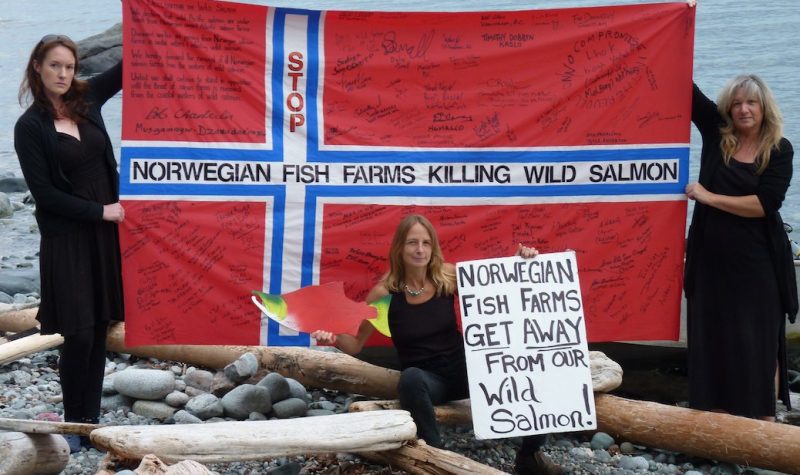By Roy L Hales
Two well known Quadra Island environmentalists are speaking out in favour of the DFO’s decision to phase out salmon farms in the Discovery Islands.
After reading the text of the BC Salmon Farmers Association’s presentation to the March 10 Strathcona Regional District (SRD) Board meeting, well known local author and Sierra Quadra Director Ray Grigg said, “they are offering nothing except for another delay, that’s all they want.”

A type of isopod, sometimes called, sea lice by Nicholette Durkan, Steamboat Mountain School, CO,NOAA Teacher at Sea Program, NOAA Ship OSCAR DYSON via Flickr (CC BY SA, 2.0 License)
Sea lice are a problem everywhere
Angela Koch, another Sierra Quadra Director and former submitter to the Cohen Commission into the Decline of Sockeye Salmon in the Fraser River said they said that "this decision was not based on science."
“I would I have to argue that point because there were nine risk assessments done, as per the Cohen Commission recommendation, but they never did a sea lice assessment. It is pretty obvious why," she said. "There was a science paper submitted at the Cohen Commission that showed back then, one farm could produce billions of sea lice. For them to say that the science is done: nobody’s buying it because the sea lice are such a huge problem.”
When the Department of Fisheries and Oceans Canada (DFO) announced they found that fish farms pose minimal risk to wild salmon migrating through the Discovery Islands, Dr. Krisiti Miller-Saunders, head of the DFO’s molecular genetics laboratory at the Pacific Biological Station in Nanaimo told the Globe and Mail that she was troubled about the assessments, and the fact department scientists depend on funding from industry.
“ …Putting scientists in the precarious position of being told that they need to go to industry to fund research means they are only asking the research questions that the industry agrees with," she said to the Globe and Mail.
Miller-Saunders asked why the spread of sea lice was not considered in the DFO's assessments?
Dr. Brian Riddell, a former senior DFO scientist and now top science adviser to the Pacific Salmon Foundation, added that sea lice are a problem with open-net aquaculture everywhere.
One of his colleagues at the Pacific Salmon Foundation, Dr. Andrew Bateman, believes DFO didn’t consider sea lice because the problem is too widespread. It would be problematic for industry.
While there are also scientists supporting the DFO assessments, a number of scientists from the Pacific Biological Station, University of Toronto, University of British Columbia and University of Victoria have recently published findings that disagree.

Ray Grigg is in favour of DFO's decision. Photo courtesy Ray Grigg.
Nothing the industry has done works: Enviromentalists
Grigg explained what has been happening with sea lice and pesticide.
“The sea lice has become immune to the pesticide they have been using, called slice. The longer they use it, the more the sea lice become immune to it until, finally, it becomes a dysfunctional remedy," he said.
David Kiemele, managing director of Cermaq Canada, recently told Cortes Currents that while it is true they sometimes need to treat salmon multiple times, the problem is sea lice in the ecosystem.
“Nothing that [the industry] has done works,” said Koch.
She was skeptical of the industry’s delousing ships. George Quocksister had recently told her that most of the fish at one farm were accidentally killed during a treatment.
Grigg mentioned some of the problems the industry has been having with a hydrogen peroxide treatment. Some of the fish were burned and there is a problem disposing of the used chemicals.

Sockeye migration routes. Image courtesy The Uncertain Future of Fraser River Sockeye Volume 3.
He stressed the fact DFO has two mandates when it comes to fish farms. In addition to protecting wild salmon, they also oversee salmon farming.
"So what happens if the two are mutually exclusive, which is what we are discovering?” said Grigg.
He claims this has been a problem wherever people try to grow fish farms alongside wild salmon..
“DFO is caught in this impossible situation and their solution is to be very selective about the information they present,” says Grigg.
He went to a meeting where DFO was sourcing information on how to protect salmon, without acknowledging that sea lice or piscine reovirus (PRV) were a problem.
“It is almost as if somebody had said you can’t talk about this stuff, so you don’t know anything about it,” said Grigg.
“The level of ignorance at that meeting was absolutely astounding," he added.
Grigg's conclusion
Grigg said that salmon farms aren't the "sole reason" for stress on the species.
“Nobody is arguing that salmon farms are the sole reason for stress on wild salmon, but it seems sensible to remove an obvious one if it is possible to do so. This needs to be done," he said.
To which Koch added, “when you think about having disease and sea lice along a migration route, that’s just insanity. To think that we should just leave them there and things are just going to be there without the farms, that’s just crazy.”

A fish farm demonstration. Photo courtesy of Angela Koch.
Links of interest
- (Globe and Mail) Scientist at Department of Fisheries and Oceans says Ottawa is to beholden to fish farm industry
- (The Royal Society) Environmental DNA from multiple pathogens is elevated near active Atlantic salmon farms
- (CBC) New study suggests fish farms raise risk of exposure to infectious disease for wild B.C. salmon
- (Nature) Descriptive multi-agent epidemiology via molecular screening on Atlantic salmon farms in the northeast Pacific Ocean
- (Global Aquaculture Alliance) In sea lice fight, salmon farmers phasing out hydrogen peroxide
- (National Library of Medicine) Gill damage and delayed mortality of Northern shrimp (Pandalus borealis) after short time exposure to anti-parasitic veterinary medicine containing hydrogen peroxide
- (Cortes Currents) A closer look at sea lice on 15 salmon farms
- (Cortes Currents) articles about, or mentioning, sea lice


